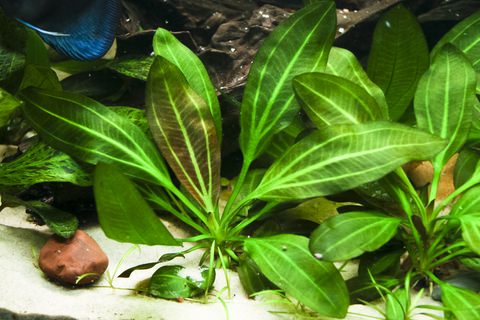| Back to Back Issues Page |
 |
|
The Goldfish Gazette, Issue #096 Plant Sterilizing December 30, 2021 |
Goldfish Care TipsA Free Monthly Resource For Goldfish Enthusiasts In This Issue Unexplained disease or parasite outbreaks can often be traced back to recently acquired aquatic plants. Plants can harbor unwanted pathogens whether sourced from a pet store, or collected from the wild. Plant Sterilizing The pathogens that cause the most problems are parasites such as flukes, anchor worm, lice and protozoan parasites such as Costia and Ich.
The pathogens that cause the most problems are parasites such as flukes, anchor worm, lice and protozoan parasites such as Costia and Ich.
Sterilization MethodsThere are three options to remove parasites from aquatic plants:1. Place them in freshwater free of fish for a period of time that ensures all pathogens will die from the lack of a host. 2. Treat with plant safe chemicals in the same way you would treat a fish being quarantined. 3. A chemical dip. Each method has advantages and disadvantages. A spare container or aquarium is required for two or more weeks for options one and two. The plants can’t be used immediately, but they are the safest options. Snails and snail eggs aren’t removed by these treatments. Option three using chemicals means the plants can be used immediately after treatment, and snails and their eggs will be destroyed. Delicate plants can be damaged using this method and it is suggested one of the other methods is used. Option One Fresh Water MethodThe plants need to be kept in isolation for a minimum period of 31 days if it is suspected they may have been exposed to lice, as the eggs take 25 days to hatch and the larvae take a further 6 days of development before they start searching for a host. 14 days isolation is adequate for the other parasite species.The container or aquarium water temperature needs to be kept at 20oC (68oF) or higher to make sure any parasites present will attempt to find a host and not go into a dormant state where they can survive for months without a host. Option Two Chemical Treatment MethodTwo medications are required to eradicate all parasite types that attack Goldfish:1. A Praziquantel based medication that will kill gill and body flukes, internal worms and protozoan parasites. 2. Any medication that kills aquatic crustaceans which lice and anchor worms are examples. No other chemicals such as salt should or need to be added to the water apart from a de-chlorinator. Option Three Chemical Dip MethodThe two most popular chemicals to use as a dip are Potassium Permanganate and plain chlorine bleach.Potassium Permanganate Potassium Permanganate is commonly sold as a treatment for parasites and bacterial infections. Like Methylene Blue it will stain anything it comes in contact with, so wear disposable gloves and eye protection as it is also a strong oxidizer. Potassium Permanganate is sold as crystals or in liquid form, so concentrations vary depending on the source. Mix enough Potassium Permanganate with water to make a dark pink solution. For most aquarium medications, this tends to be about twice the recommended dosage when sold as a fish medication. Soak the plants in the solution for 15-20 minutes before placing them in freshwater that has had a de-chlorinator added. The de-chlorinator will neutralize the Potassium Permanganate. Let them soak in the freshwater fully submerged for a further 10-15 minutes to ensure the plants are free of any residual chemical and any killed pathogens can float free of the plants. Chlorine Bleach A bleach dip is the most severe sterilizing method for treating plants. If delicate plants need to be sterilized it is recommended that one of the other two options be used. Some plants will not tolerate bleach at a concentration that is needed to be effective against parasites. The bleach to use is plain bleach, not a scented or concentrated bleach, at a concentration of 5% as recommended by plant sellers. Measure out a solution of 19 parts water to 1 part bleach, and soak the plants for no more than 3 minutes, less for delicate plants. Rinse them in de-chlorinated water then transfer them to a container of freshwater that has had a de-chlorinator added. Let them soak completely submerged for 10-15 minutes. After soaking, smell the plants for any bleach odor. There should be none but if there is, re-rinse and re-soak for a further 10 minutes. Celestial Fry Growth UpdateOne of the 7 test juveniles has now reached 75mm in body length.This test has produced several surprising outcomes. The 5 reject juveniles put into an outside 300L pond in much colder water and fed sparingly have, on average, attained the same body length as the average size of the 7 test fish. I am now going to test a few theories which will take a few months and report back on the findings. Happy New Year!Well, another year has flown by, Santa has been and gone, and Covid-19 is still with us.The past two years have had their challenges. Let's make the new year better than the last two. I wish you, your families, and your Goldfish a happy and prosperous 2022. Keep safe. Comments? Ideas? Feedback? I'd love to hear from you. Just reply to this e-zine and tell me what you think, or what topics you want covered. Next Month's Topic Goldfish Lifespanswww.facebook.com/aboutgoldfish |
| Back to Back Issues Page |